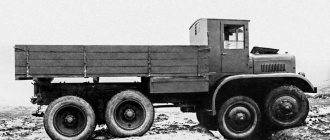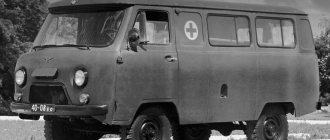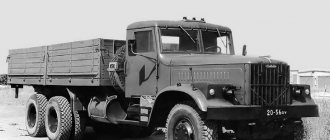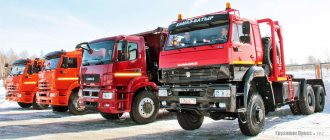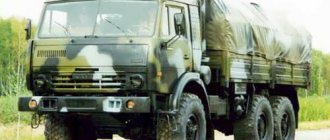History of KAMAZ: from the USSR to the present day
Born half a century ago as the largest manufacturer of heavy-duty vehicles, the Kama Automobile Plant still retains its status, despite all the vicissitudes of fate.
Valery Vasiliev
The sixties of the last century. The growing economic power of the Soviet state contributes to a significant increase in cargo transportation volumes. The country is in dire need of heavy-duty vehicles with fuel-efficient diesel engines, but existing car factories are unable to cover this deficit. There is a growing need for the construction of a new auto giant.
In August 1969, the Central Committee of the CPSU and the Council of Ministers of the USSR adopted Resolution No. 674 “On the construction of a complex of automobile factories in Naberezhnye Chelny of the Tatar Autonomous Soviet Socialist Republic.” The production volume was determined at 150 thousand cars and 250 thousand diesel engines. On September 26, 1969, the Minister of Automotive Industry Alexander Tarasov signed an order naming the new enterprise the Kama Automobile Plant, and on December 13, excavator operator Mikhail Noskov began work at the site of the first KAMAZ facility. This date is the official start of construction of the plant.
Based on the experience of GAZ, they expected to buy the design of the truck from leading foreign companies. But neither Ford nor Daimler were able to cooperate with the USSR in the realities of the Cold War, due to NATO fears of strengthening Soviet military power. I had to rely on my own strength. The choice fell on ZIL, where at that time the creation of a family of promising trucks with a cab over the engine was underway, including models with a 6x4 wheel arrangement for operation as part of road trains with a gross weight of 26.5–32 tons and vehicles (6x6) for 24-ton road trains .
This is how the promising ZIL-170 was depicted in 1967 by factory designer Lev Samokhin.
Just in time for 1968, the capital's plant built the first prototype of the ZIL-2E170V truck tractor with a YaMZ-6E641 diesel engine with a power of 210 hp. With. These developments formed the basis for future KAMAZ trucks. The new 6x4 trucks were designed for use on a larger road network with load-bearing capacities of 6 tonnes on a single axle and 11 tonnes on a bogie.
The ancestor of KAMAZ is the ZIL-2E170V truck tractor.
In addition to ZIL, other enterprises in the country also took part in the project. The Yaroslavl Motor Plant developed V-shaped diesel engines KAMAZ-740 and KAMAZ-741 with a power of 180, 210 and 260 hp. s., clutch and gearbox. The Odessa Automobile Assembly Plant worked on the designs of semi-trailers for truck tractors, the Head Trailer Design Bureau in Balashov worked on trailers for tractor-trailers, and the Minsk Automobile Plant was creating dump trucks.
From 1969 to 1978, ZIL built more than 50 prototypes of KAMAZ vehicles, the total mileage of which during road tests amounted to 4.5 million km. For the Kama Automobile Plant they created an extensive line of trucks with 6x4 and 6x6 wheel arrangements (truck tractors, flatbed vehicles, dump trucks), which were then produced by the company for decades. At the same time, the newcomers were not inferior in their level to the best foreign analogues.
It must be said that more than 100 thousand people worked at the construction site of the century in Naberezhnye Chelny. KAMAZ orders for construction materials and equipment were fulfilled by over 2,000 enterprises of the USSR. The future automobile plant was provided with the most modern technological equipment. Over 700 foreign companies took part in equipping it. Thanks to unprecedented amounts of funding, work was carried out at an incredibly high pace. So, if in the fall of 1970 the first cubic meters of concrete were laid in the foundation of the repair and tool plant, then already in 1973 the buildings of almost all of the first stage of KAMAZ facilities were erected.
As a result, the Chelny first-born, the 8-ton KAMAZ-5320 flatbed, rolled off the main assembly line on February 16, 1976. A little later, the state commission signed an act on the commissioning of the first stage of the Kama complex of factories for the production of heavy trucks. Production volumes also grew at a record pace. In the summer of 1979, we crossed the 100 thousand truck mark.
The Chelny first-born - KAMAZ-5320 rolled off the main assembly line on February 16, 1976.
In 1976–1978, the production program included three basic models. Along with KAMAZ-5320, a 10-ton KAMAZ-5511 dump truck and a KAMAZ-5410 truck tractor were produced for operation as part of a road train with a total weight of 26 tons. In subsequent years, a 10-ton KamAZ-53212 truck with an elongated wheelbase, the KAMAZ-53211 chassis and KamAZ-53213 with a carrying capacity of 11 tons, an agricultural 7-ton KamAZ-55102 with side unloading and a camaz-54112 for a 33-tonnic vehicle for a 33-tonnic carrier appeared. road trains.
In 1981, the second stage of the plant began operating. Here they launched the production of a 6-ton army version of the KAMAZ-4310 (6x6) with a winch, two fuel tanks and a tire pressure regulation system. A 7-ton version of KAMAZ-43105 was offered to farmers. In those same years, all base models were equipped with engines that increased to 220 hp. With. power and a 10-speed gearbox. In October 1988, the millionth truck left the assembly line.
All-wheel drive KAMAZ-4310, 1981.
At the end of the 1980s, the company began developing second-generation cars. The updated models were equipped with domestic turbodiesels, as well as imported engines and components. Cabin comfort has been improved due to a higher roof and a number of technical improvements. At the same time, the KAMAZ-5325 flatbed tractor and the KAMAZ-5425 (4×2) truck tractor appeared. In 1987, the VAZ-1111 Oka subcompact car went into production, which was produced until 1994.
Truck tractor KAMAZ-5325, 1988.
On August 23, 1990, the KAMAZ production association was transformed into a joint stock company. With the transition to a market economy and the appearance of imported equipment on the Russian market, sales problems began, huge capacities were actually idle, and the financial condition of the enterprise sharply deteriorated.
The picture was further aggravated by the fire that occurred in April 1993 at the KAMAZ engine plant, which completely destroyed it. But, relying on the support of the entire country, the enterprise restored its engine production capacity and also put into operation the latest technological equipment. Engine production resumed in December 1993.
Since 1995, the third generation of trucks entered the series, based on the modernized family of 6x4 vehicles. Among these models were an 11-ton flatbed KAMAZ-53215, a 6.6-cc dump truck KAMAZ-55111.02, a truck tractor for a 36-ton road train KAMAZ-54115, a long-wheelbase KAMAZ-53229 chassis with a lifting capacity of 17 tons, a KAMAZ-5513 chassis for concrete mixers and replacement bodies.
11-ton flatbed truck KAMAZ-53215.
At the end of the 1990s, new models of dump trucks appeared - the 13-ton KAMAZ-55112 and the 15-ton KAMAZ-65115. The two-axle road truck KAMAZ-4325 was equipped with a 240-horsepower engine. Its all-wheel drive version was the 4-ton KAMAZ-4326.
At the same time, the plant developed new models, which became a further development of previous models. A 13-ton KAMAZ-53228 timber truck and a KAMAZ-65111 (6x6) dump truck with a lifting capacity of 14 tons were based on a three-axle chassis. In 1996, they introduced the KAMAZ-6520 (6x4) chassis with a carrying capacity of 20–22 tons for installing superstructures, as well as a 19-ton KAMAZ-6522 (6x6) dump truck with a 12-cc body. They were equipped with a new KAMAZ-740.51 turbodiesel with a power of 320 hp. pp., 8‑speed gearbox. The development of these vehicles was the KAMAZ-6340 chassis (8x4) with a lifting capacity of 16 tons for the installation of superstructures, on the basis of which the 18.5-ton KAMAZ-6540 dump truck was produced since 1996.
Dump truck KAMAZ-6520, 2002.
In 2000, economical 6x4 vehicles appeared - the 14-ton flatbed KAMAZ-65117 (260 hp) and the KAMAZ-65116 truck tractor - successors to the KAMAZ-53212 and KAMAZ-54112 models, respectively, as well as the 14.5-ton KAMAZ-54112 dump truck. 45231 with three-way discharge. At the same time, a presentation of the new NefAZ-5299 bus based on KAMAZ-5297 took place, and in November 2003, the KAMAZ-4308 city delivery vehicle was launched into production.
From 2005 to 2009, KAMAZ created joint ventures with ZF, Cummins, Knorr-Bremse, Federal Mogul and Daimler to produce transmission units, diesel engines, brake systems, cylinder-piston parts and assemble Fuso trucks. Somewhat earlier, in December 2008, Daimler AG acquired 10% of KAMAZ.
Flatbed truck KAMAZ-53082, 2007.
At the beginning of 2010, the plant mastered mass production of cars with restyled cabs, and in 2012 the 2 millionth truck rolled off the assembly line. At the same time, an agreement was signed with Daimler Trucks, according to which KAMAZ was given the technology for producing Axor cabs for installation on new generation trucks. The result was the serial production at the end of 2013 of the new flagship of the model range - the KAMAZ-5490 long-haul tractor.
All-wheel drive KAMAZ-43118‑24, 2010.
In 2014, the KAMAZ-65206 truck tractor and the KAMAZ-65207 flatbed long-haul truck got a start in life, and even then they opened a building for the production of KAMAZ vehicles and bus chassis with gas engines, and began testing a drone developed jointly with VIST Group and Cognitive Technologies.
In 2022, the company developed and brought to market over 100 truck and chassis configurations, including five new models of the K-4 generation - a truck tractor, dump trucks and chassis. Along with this, they demonstrated the first sample of the KAMAZ-54901 long-haul tractor of the K5 generation, and in December 2022, the engine plant assembled the first samples of the KAMAZ910.10 in-line 6-cylinder diesel engine for K5 series trucks. The company became the first domestic company to master the production of the KAMAZ-6282 electric bus, charged from an ultra-fast charging station.
Electric bus KAMAZ-6282.
This year is marked by the beginning of mass production of K5 generation cab frames at a plant built jointly with Daimler AG, the production of an industrial batch of KAMAZ-54901 long-haul tractors, as well as the premieres of the KAMAZ-65659 (6x4) truck tractor, the updated KAMAZ-5490 NEO2 tractor, and the KAMAZ electric vehicle -53198, KAMAZ-6595 dump truck, prototype of the KAMAZ-6355 (8x8) “Arctic” articulated all-terrain vehicle. Chelny residents associate their immediate prospects with multi-axle dump trucks of the Samson family with a lifting capacity of 55 and 70 tons, the self-piloted SHUTL electric bus, and the energy-efficient KAMAZ-2020 long-haul tractor.
Over its 50-year history, the Kama Automobile Plant has produced about 2.3 million cars and about 2.9 million engines. It is not surprising that every third truck with a gross weight of 14-40 tons on the roads of Russia and the CIS countries is a KAMAZ. In addition, machines from Naberezhnye Chelny operate in more than 80 countries around the world.
The editors recommend:
Why do piston rings stick and how to prevent it?
A traffic police officer searched my car: did he have the right to do so?
Russians may be left without foreign cars: Western automakers have stopped supplying cars to our country
A ship that was transporting cars to Russia was detained in France
Half of the car factories in Russia have closed
News Media2
Discussion is closed.
Birth of a legend
In the 1960s, the Soviet Union experienced an acute shortage of trucks capable of carrying loads weighing more than 8 tons. At the same time, the development of cars of this class was already underway, but there was no production of suitable power in the country. In 1969, the government decided to build a new plant. Regions competed for the right to host the construction, because this meant a gigantic influx of funds and resources into the region for many years. As a result, Naberezhnye Chelny was chosen, at that time a small town in the Republic of Tatarstan. The choice of the city was influenced by its location in the center of the European part of the USSR, the proximity of railways and river routes. An important condition was the presence of the Nizhnekamsk hydroelectric power station, already under construction, near the city.
The enterprise has become a city-forming one. During the first five years of construction, the population of Naberezhnye Chelny grew sixfold: from 37 thousand to 231 thousand inhabitants. People from all over the Union came to the Komsomol shock construction site. In addition to the plant itself, housing, communications, infrastructure, hospitals, schools and much more were built.
It was truly a grandiose construction project. More than 2,000 contractors throughout the country carried out orders for the construction of the KAMAZ plant. 700 foreign companies provided their equipment and technologies. The enterprise's capacity was designed to produce 150 thousand trucks and 250 thousand engines per year. In 1973, the first stage of construction of the giant plant buildings was completed.
Activity
is a full-cycle automotive production unit, combining metallurgical, forging, press-frame, mechanical assembly, special mechanical engineering and tool production with all the necessary energy and auxiliary facilities as part of 16 specialized plants in the Russian Federation and the CIS countries, of which 9 are in Naberezhnye Chelny. In addition to development and production, the company is engaged in servicing of trucks and cars, domestic and foreign trade and other activities.
The main production facilities of the plant are located in the industrial zone of Naberezhnye Chelny. Buses are produced in Neftekamsk (Bashkortostan).
Pantsir-S1 on 8×8 KAMAZ 6560 chassis
There are also overseas production facilities in the following countries:
- Kazakhstan India Azerbaijan Ukraine Ethiopia Vietnam Pakistan (since November 19, 2006) Iran North Korea. Poland
Opening of a KAMAZ service center in Turkmenistan
KAMAZ service center in Turkmenistan
The sales geography of KAMAZ vehicles and spare parts is rapidly expanding due to the development of new markets:
- Saudi ArabiaIndia Chile Nicaragua Sudan Afghanistan Angola Venezuela Panama Turkmenistan
4.1. Group structure
has more than 110 subsidiaries and affiliates, owns shares in the authorized capitals of more than 50 different companies and enterprises. Together they form the KAMAZ Group
Fire truck on KAMAZ chassis
The group includes:
- Automobile plant (Naberezhnye Chelny) -Metallurgy"
Kama Foundry (now one of the largest in Russia[10])
Kama Forge Plant
Kama Automechanical Plant
- press-frame plant" -Diesel -financial company "KAMAZ" "automobile plant" (NEFAZ) -KAMAZ" (Former SZAP Stavropol) Dealer OJSC"KIP "Master" -FINANCE" -CAPITAL" Scientific and technical.
The production volume of trucks in 2008 was 51 thousand vehicles (a drop of 3%). In the HCV segment, the automaker produced 35,508 units (26.5% of total sales in this segment).[11]
Before the global crisis, in ten months of 2008, the group’s enterprises shipped 79 billion 150 million rubles worth of commercial products to their consumers. The following were produced and sold: 44,533 trucks (+3.0% compared to 2007); engines and power units (+12.3% compared to 2007).
The group's revenue in 2010 according to IFRS amounted to 73.77 billion rubles. (in 2009 - 60.1 billion rubles, in 2008 - 96.348 billion rubles), net loss - 889 million rubles. (in 2009, a net loss of 2.6 billion rubles, in 2008, a net profit of 1.065 billion rubles)[12][6][13].
4.3. Development plans
On November 21, 2008, we considered the possibility of creating an assembly plant in Cuba. It is planned that production volumes there will be 500 cars per year[14].
Brand designations
KAMAZ-55111 at a construction site in Poland
The open joint-stock company KAMAZ was created on August 23, 1990 by transforming the KAMAZ Production Association of the USSR Ministry of Automotive and Agricultural Engineering into an open joint-stock company in accordance with Resolution of the Council of Ministers of the USSR No. 616 of 01/01/01. It became one of the largest enterprises in the USSR.
Previously, the name of the company changed several times:
- In the years - it was called the Kama Automobile Plant
-
the management of the Kama Automobile Plant
(they used the two names equally);
Since 1973 - Kama complex of factories for the production of heavy-duty vehicles
; Since 1976 - Production Association "KAMAZ"
, since 1973, has owned the trademarks KAMAZ and KAMAZ, and since 1987, the combined trademark KAMAZ with the image of a wild steppe horse (Argamak). These trademarks are recognized as well-known on the territory of the Russian Federation by decisions of the Chamber for Patent Disputes of the Federal Service for Intellectual Property, Patents and Trademarks, starting from December 31, 1999[8].
The previously used name "KAMAZ" is no longer used. For example, currently both the brand name and vehicle brands on products are written in uppercase, for example: “KAMAZ-43114 flatbed tractor.”[9]
Owners and management
The authorized capital of KAMAZ is 35.36 billion rubles. Shareholders of the plant as of June 2010[6]:
- 49.9% of shares belong to the state corporation Rostekhnologii; 27.3% controls; 11% belongs to Daimler (a 10% stake was sold to Daimler for $250 million in early December 2008); 4% is controlled by the European Bank for Reconstruction and Development.
At the same time, KAMAZ has many small shareholders (over 76 thousand individuals)[7]
At the beginning of March 2008, the board of directors of KAMAZ was elected, which included 15 people, including:[1]
- Mayor of Naberezhnye Chelny (since April 2010 - Prime Minister of Tatarstan) - Ildar Shafkatovich Khalikov, Head of the Federal Property Management Agency - Ivan Viktorovich Aksenov, General Director of the state corporation "Rostechnologies" Sergei Viktorovich Chemezov.
2.1. Senior executives
- 1969–1981 — Vasiliev, Lev Borisovich, General Director of PA KamAZ 1981–1987 — Faustov, Vasily Alekseevich, General Director of PA KamAZ 1987–1991 — Bekh, Nikolay Ivanovich, General Director of PA KamAZ 1991–1997 — Bekh , Nikolay Ivanovich, President, General Director 1997?2002 - Kostin, Ivan Mikhailovich, General Director 2002? n. V. — Kogogin, Sergey Anatolyevich, General Director
Sport
KAMAZ truck at the 2006 Lisbon-Dakar rally
The KAMAZ-master team takes an active part in various rallies held around the world. KAMAZ trucks became winners in the Dakar rally (formerly Paris-Dakar) 10 times:
6.1. List of winners
| Year | Team | Route | ||
| Pilot | A country | Manufacturer | ||
| 2011 | Chagin | Russia | Kamaz 4326-9 | Buenos Aires - Antofagasta - Buenos Aires |
| 2010 | Chagin | Russia | Kamaz 4326-9 | Buenos Aires - Antofagasta - Buenos Aires |
| 2009 | Kabirov | Russia | Kamaz 4326-9 | Buenos Aires - Valparaiso - Buenos Aires |
| 2006 | Chagin | Russia | Kamaz 4911 | Lisbon - Dakar |
| 2005 | Kabirov | Russia | Kamaz 4911 | Barcelona - Dakar |
| 2004 | Chagin | Russia | Kamaz 4911 | Clermont-Ferrand - Dakar |
| 2003 | Chagin | Russia | Kamaz 4911 | Marseille - Sharm el-Sheikh |
| 2002 | Chagin | Russia | Kamaz 49256 | Arras - Madrid - Dakar |
| 2000 | Chagin | Russia | Kamaz 49252 | Paris - Dakar - Cairo |
| 1996 | Moscow | Russia | Kamaz 49252 | Granada - Dakar |
Products
KAMAZ 55111
KAMAZ in the center of Warsaw
Timber truck
KAMAZ produces the following range of trucks:
- Onboard tractors KAMAZ 43253
(4x2)
KAMAZ 43118
(6x6)
KAMAZ 43114
(6x6)
KAMAZ 65117
(6x4)
KAMAZ 5320
(6x4) - discontinued
KAMAZ 53212
(6x4) - discontinued
KAMAZ 4326
(4) ×4)
KAMAZ 4355
(6×6)
- Truck tractors KAMAZ 5410
(6x4) - discontinued
KAMAZ 54115
(6x4)
KAMAZ
(4x2)
KAMAZ 65116
(6x4)
KAMAZ 6460
(6x4)
KAMAZ 44108
(6x6)
KAMAZ 65225
(6x6)
KAMAZ 65226
(6x6)
- Dump trucks KAMAZ 6520
(6x4) - the basic model of the family with increased payload capacity[15]
KAMAZ 6540
(8x4)
KAMAZ 6522
(6x6)
KAMAZ 55111
(6x4)
KAMAZ 65115
(6x4)
KAMAZ 65111
(6x6)
KAMAZ 65201
(8x4)
KAMAZ 53605
( 4x2)
KAMAZ 43255
(4x2)
KAMAZ 45141
(6x6)
- Sports truck KAMAZ 4911
(4x4)
Medium-duty vehicle
- KAMAZ 4308
(4x2)
- Chassis KAMAZ 43118
(6x6)
KAMAZ 65115
(6x4)
KAMAZ 6522
(6x6)
KAMAZ 6540
(8x4
6520
(6x4
KAMAZ 43253
(4x2
KAMAZ 65117
(6x4)
KAMAZ 4326
(4x4)
KAMAZ 43114
(6× 6)
KAMAZ 53215
(6x4)
KAMAZ 4308
(4x2)
KAMAZ 55111
(6x4)
KAMAZ 53205
(6x4) KAMAZ 53229 (6x4)
KAMAZ
53228 (6x6
)
KAMAZ 4355 (6x6)
KAMAZ 4310
(6x6)
KAMAZ 6350
(8x8)
Armored car
- KAMAZ BPM-97
“Shot” (4×4)
Introduction
, 1974
(eng. KAMAZ
) (
Kama Automobile
Plant
Russian the
CIS
for the production of heavy-duty vehicles, tractors, diesel engines, electrical units and components, located in Naberezhnye Chelny (Tatarstan, Russia).
As of 2010, it ranks 13th among the world's leading companies producing heavy trucks, and ranks 8th in the world in terms of production of diesel engines[1][2].


